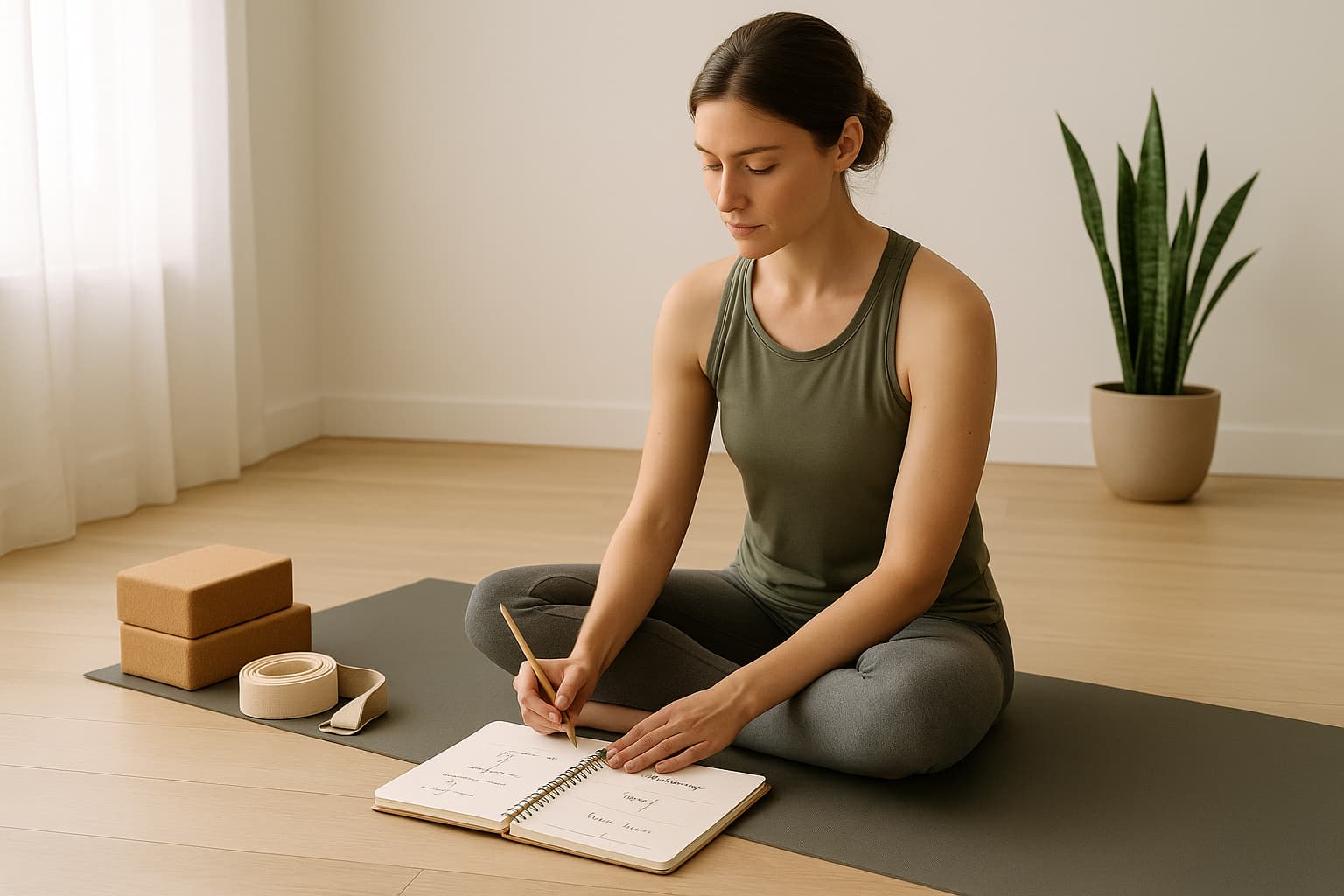The Purpose Behind a Yoga Lesson Plan
A well-developed yoga lesson plan acts as a compass for instructors. Rather than relying on spontaneity, teachers with a clear plan deliver classes that feel intentional, grounded, and cohesive. Structured planning helps eliminate second-guessing during class, which frees you to stay present and responsive to your students.
Each lesson should have a distinct purpose. This might center around physical goals, such as building core strength, or more subtle aims like nervous system regulation. When your plan reflects a specific outcome, it helps you sequence postures, choose cues, and guide transitions more effectively. Planning also ensures that every pose contributes meaningfully to the overall arc of the session.
Additionally, a lesson plan helps with class consistency:
- You maintain an even pace from start to finish.
- It’s easier to manage timing and avoid overloading students.
- You stay on track even if students arrive late or energy shifts unexpectedly.
Planning also helps maintain inclusivity. If your class includes multiple skill levels, your outline should offer tiered pose options and accessible transitions. This avoids overwhelming newer students while still challenging experienced practitioners.
By taking time to plan before you teach, you show up with greater clarity and adaptability. That preparation not only supports your confidence as a teacher—it also deepens your students’ trust and engagement throughout the class.
Core Elements Every Yoga Lesson Plan Should Include
Establishing the Class Theme and Student Goals
Choosing a class theme and defining student goals are critical steps in building a yoga lesson plan that feels purposeful and cohesive. Without a theme, your class can lack focus; with one, each element of the experience becomes more intentional and connected.
Start by identifying what your students need today. Consider energy levels, time of day, season, or any recurring issues they’ve mentioned. Are they seeking calm or strength? Stillness or movement? Do they need grounding after a hectic day or energizing after a sluggish one?
Then, select a theme that aligns with those needs. Strong themes often revolve around:
- Physical focus: hips, shoulders, hamstrings, core
- Energetic intention: grounding, expansion, balance, release
- Emotional tone: confidence, clarity, acceptance, resilience
- Spiritual concepts: surrender, self-inquiry, compassion
Once chosen, this theme should inform your sequence, cues, and pacing. For instance, if you’re teaching a class focused on surrender, incorporate longer holds, deep hip openers, and breath-led transitions. Use language that supports letting go throughout your verbal guidance.
Finally, state your theme clearly—whether aloud at the start of class or simply through the structure of your flow. Even if unspoken, your choices will communicate the theme through rhythm, tone, and pose selection. This alignment turns a simple class into a meaningful, embodied experience.
Structured Class Segments from Start to Finish
Dividing your yoga class into clear segments helps maintain flow and keeps students engaged. Each section should serve a specific purpose and build upon the one before it.
Use this simple structure as a foundation:
- Opening (5–10 min): Grounding meditation, breath awareness, and gentle movements to settle the body and mind.
- Warm-Up (10 min): Dynamic stretches like Cat-Cow or lunges to prepare joints and activate muscles.
- Main Sequence (20–25 min): Purposeful progression toward a peak pose, with logical transitions and variations for multiple skill levels.
- Cool Down (10 min): Seated or supine stretches to release tension and begin integration.
- Closing (5 min): Guided breath, silent reflection, or Savasana to complete the practice.

Organizing your yoga class this way ensures physical balance, emotional cohesion, and a complete experience for every student.
Considerations for Timing and Transitions
Managing time and transitions is just as important as choosing the right poses. Without clear pacing, your class can feel rushed or drag unnecessarily. Allocate estimated minutes to each section and stick to them—especially when teaching a set-length session.
For example:
- Warm-up: 10 minutes
- Main sequence: 25 minutes
- Cool down: 10 minutes
- Savasana: 5–10 minutes
Plan transitions between postures with care. Avoid abrupt shifts that break focus or feel jarring to the body. Use breath cues (“inhale, step forward”) or bridge poses (like Downward Dog) to link movements fluidly.
When teaching mixed-level classes, slower transitions give newer students time to process cues while allowing experienced students to deepen or refine their alignment. Practice timing your flow while rehearsing your sequence—it’ll help you stay present while keeping your class on track.
Designing a Yoga Class That Meets All Skill Levels
Inclusive Planning Through Pose Options
A well-rounded yoga lesson plan must accommodate varying skill levels within the same class. Offering pose options ensures that all students feel seen, safe, and empowered—whether they’re stepping onto the mat for the first time or have years of experience.
When selecting postures, prioritize flexibility in how they can be practiced. For example:
- Plank: Offer forearm plank or knees-down variation.
- Warrior II: Cue a shorter stance or use a block under the front hand.
- Bridge Pose: Suggest supported bridge with a block under the sacrum.
Keep props accessible and cue them early. Encourage exploration without judgment. Remind students that choosing a modification isn’t a step down—it’s a conscious way to listen to the body.
Planning for inclusivity in your yoga class also means watching your language. Instead of saying “if you can’t,” try “if you’d like” or “another option is.” This subtle shift invites participation instead of limitation.
Customizing Lessons Based on Student Feedback
Student feedback is an invaluable tool for refining your yoga classes over time. While your initial lesson plan sets the foundation, adapting based on real-time observations and post-class reflections helps you meet evolving needs with precision.
Encourage informal feedback through casual conversation after class or brief check-ins beforehand. Pay attention to common themes—tight shoulders, stress, balance challenges—and weave those insights into future sessions.
You can customize in several ways:
- Shift your focus (e.g., add more hip mobility if students mention tightness)
- Adjust pacing (speed up or slow down based on energy levels)
- Offer pose alternatives in response to physical limitations
Even if you don’t change your entire plan, small adjustments show students you’re listening. Over time, this feedback loop deepens connection, trust, and retention.
Stay flexible—your plan should guide, not restrict, how you support your students.
Refining and Reusing Your Lesson Plan Library
Building a Repeatable Framework for Yoga Teaching
Creating a repeatable framework streamlines your class planning process and ensures consistency across your teaching schedule. Rather than reinventing each class from scratch, build a few reliable templates that you can customize with new themes, postures, or breath practices.
Start with a base outline that includes:
- Opening breathwork or meditation
- Warm-up sequence
- Peak pose progression
- Cool down
- Savasana or closing ritual

From there, layer in variations depending on class goals, energy levels, or time constraints. Keep a library of past plans, organized by theme, anatomical focus, or class type. This archive becomes a valuable resource when planning workshops, privates, or multi-week series.
A structured framework reduces mental load and supports creativity. It allows you to focus more on teaching in the moment while knowing your foundation is strong.
Use reflection notes to refine your templates regularly. Over time, your framework will evolve alongside your growth as a teacher.

